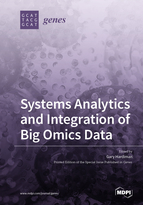Systems Analytics and Integration of Big Omics Data
A special issue of Genes (ISSN 2073-4425). This special issue belongs to the section "Technologies and Resources for Genetics".
Deadline for manuscript submissions: closed (31 August 2018) | Viewed by 93010
Special Issue Editor
Interests: computational biology; genomics and genetics; big data; pharmacogenomics; endocrine disruption; systems biology
Special Issues, Collections and Topics in MDPI journals
Special Issue Information
Dear Colleagues,
The emergence and global utilization of high-throughput (HT) technologies, including deep sequencing technologies (genomics) and mass spectrometry (proteomics, metabolomics, lipidomics), has allowed geneticists, biologists, and biostatisticians to bridge the gap between genotype and phenotype on a scale that was not previously possible. The adoption of a novel technology is met by a paradigm shift in how biological assays are designed and executed.
Throughput is increased typically by an order of magnitude and accompanied by an exponential cost reduction compared to older traditional approaches. The economic benefit and efficacy of nascent technologies is often realized by process-miniaturization combined with the multiplexing of millions of reactions.
Big data encompasses the collection of data sets derived from technologies. They are so large and complex that their processing is impractical using traditional data processing applications. Instead, challenges arise in collection: analysis, mining, sharing, transfer, visualization, archival and integration of big data.
Analogous to the impact of high-throughput DNA sequencing on genomics and transcriptomics, mass spectrometry has revolutionized proteomics studies in a similar manner providing independent draft maps of the human proteome. Large-scale interrogation of biological systems using mass-spectrometry based proteomics provides insights not available from genomics data, namely information on protein abundance, cell-type and time-dependent expression patterns, post-translational modifications and protein–protein interactions.
As observed with DNA microarray analysis pipelines over a decade ago, and more recently with HT sequencing, better analytical tools are emerging primarily from open source efforts permitting additional analyses and enhanced information mining from raw data sets compared to the tool kits provided with the instruments themselves.
Various statistical pipelines require different types of compute structure: large database storage arrays for query intensive data analysis, high throughput sequencing requiring a high-speed data networks with a hierarchical type compute core, statistical modeling methods requiring a modular type closely coupled compute infrastructure
Administration and development strategies must take into account the ever-growing size of data, public accessibility of analyzed data, software deprecations, software upgrades, hardware failures, user interface improvements, user account management, long term storage as well as security of systems.
In this Special Issue, we will focus on integration strategies for systems level analysis of omics data, big data infrastructure, rigor and transparency in big data research, best practices for sharing omics data with public repositories, recent developments in pathway and network algorithm development, and integration of omics data with clinical and biomedical data.
Prof. Dr. Gary Hardiman
Guest Editor
Manuscript Submission Information
Manuscripts should be submitted online at www.mdpi.com by registering and logging in to this website. Once you are registered, click here to go to the submission form. Manuscripts can be submitted until the deadline. All submissions that pass pre-check are peer-reviewed. Accepted papers will be published continuously in the journal (as soon as accepted) and will be listed together on the special issue website. Research articles, review articles as well as short communications are invited. For planned papers, a title and short abstract (about 100 words) can be sent to the Editorial Office for announcement on this website.
Submitted manuscripts should not have been published previously, nor be under consideration for publication elsewhere (except conference proceedings papers). All manuscripts are thoroughly refereed through a single-blind peer-review process. A guide for authors and other relevant information for submission of manuscripts is available on the Instructions for Authors page. Genes is an international peer-reviewed open access monthly journal published by MDPI.
Please visit the Instructions for Authors page before submitting a manuscript. The Article Processing Charge (APC) for publication in this open access journal is 2600 CHF (Swiss Francs). Submitted papers should be well formatted and use good English. Authors may use MDPI's English editing service prior to publication or during author revisions.
Keywords
- systems level analysis
- high-throughput sequencing
- mass spectrometry
- bioinformatics pipelines
- rigor and transparency in big data research
- omics data management
- analysis provenance
- algorithm development for pathway/network integration







